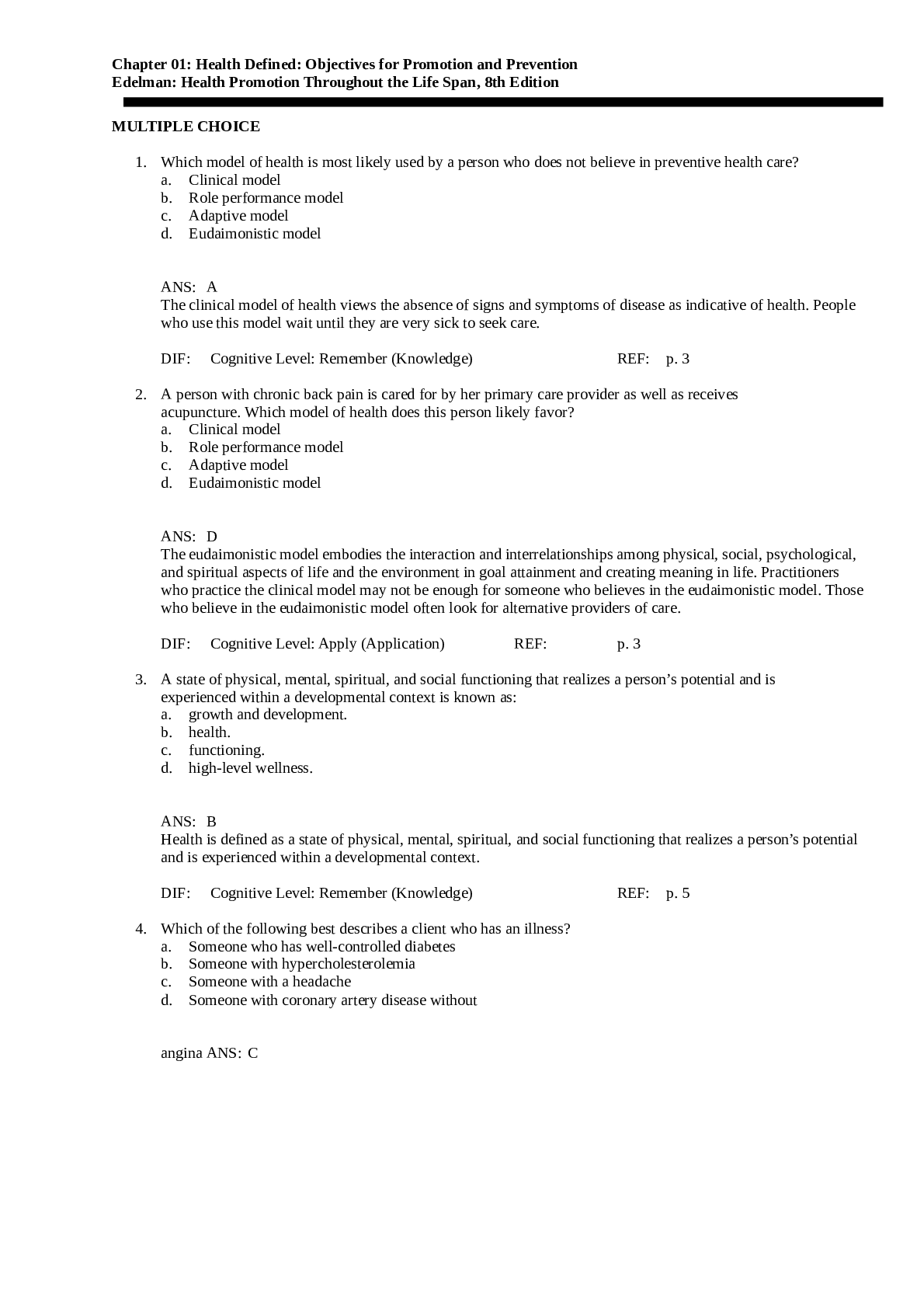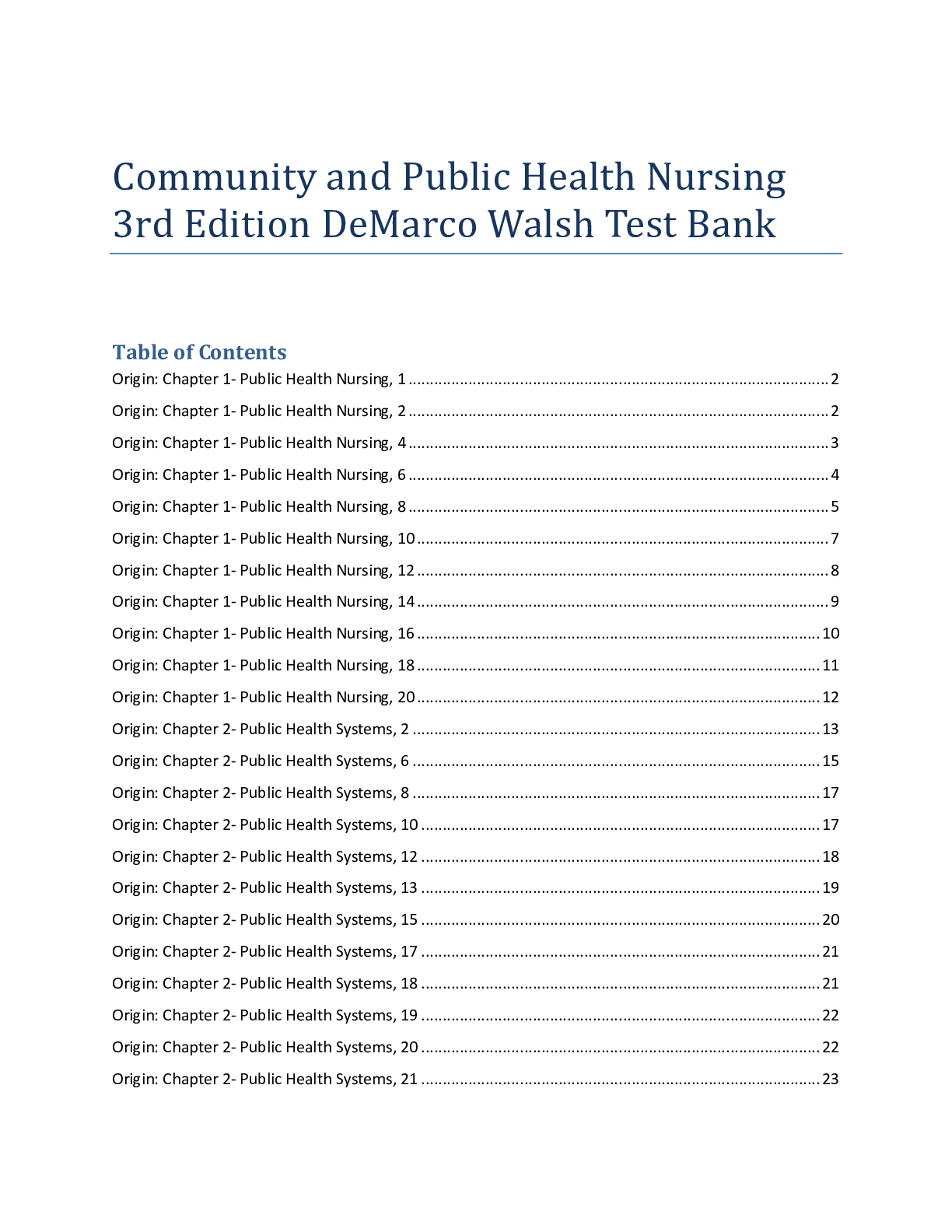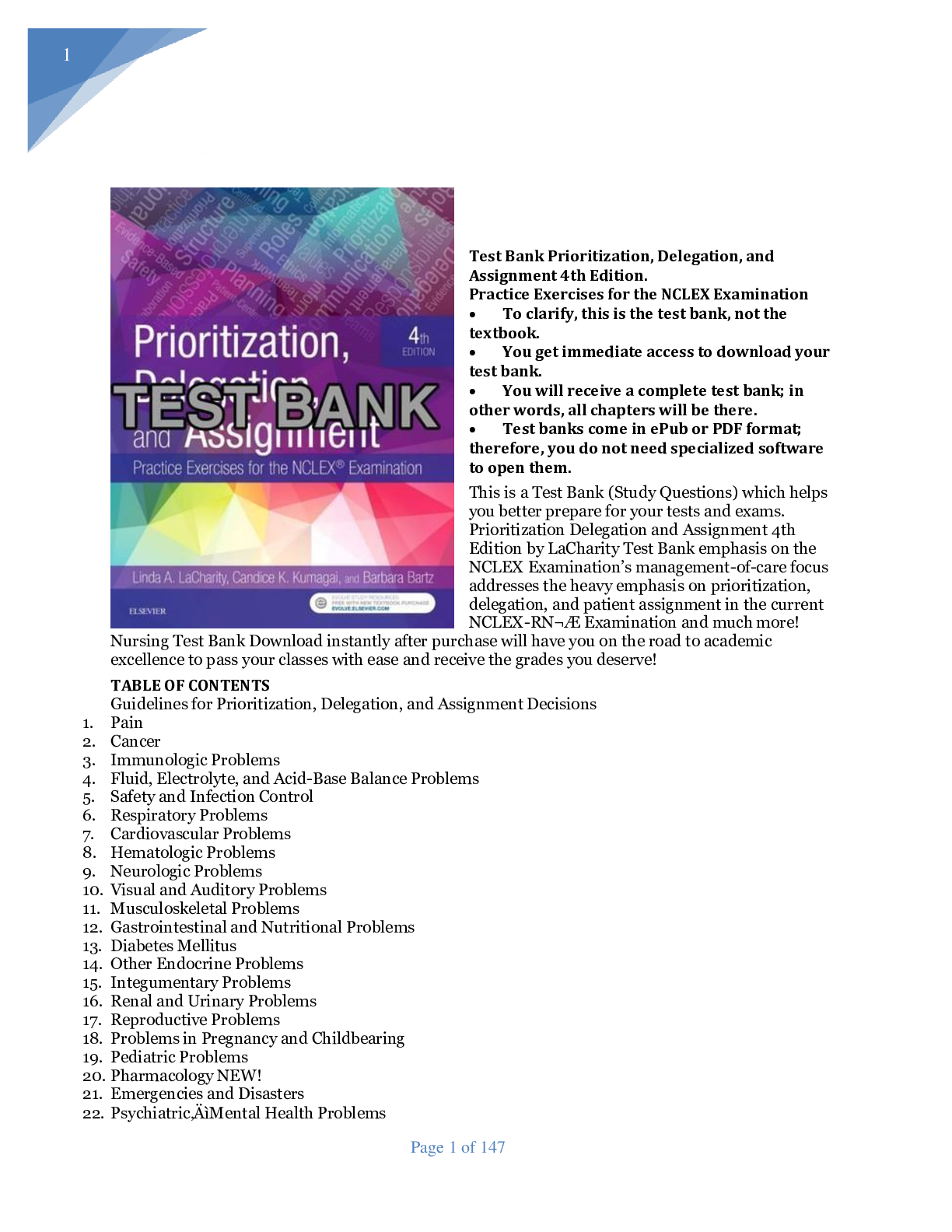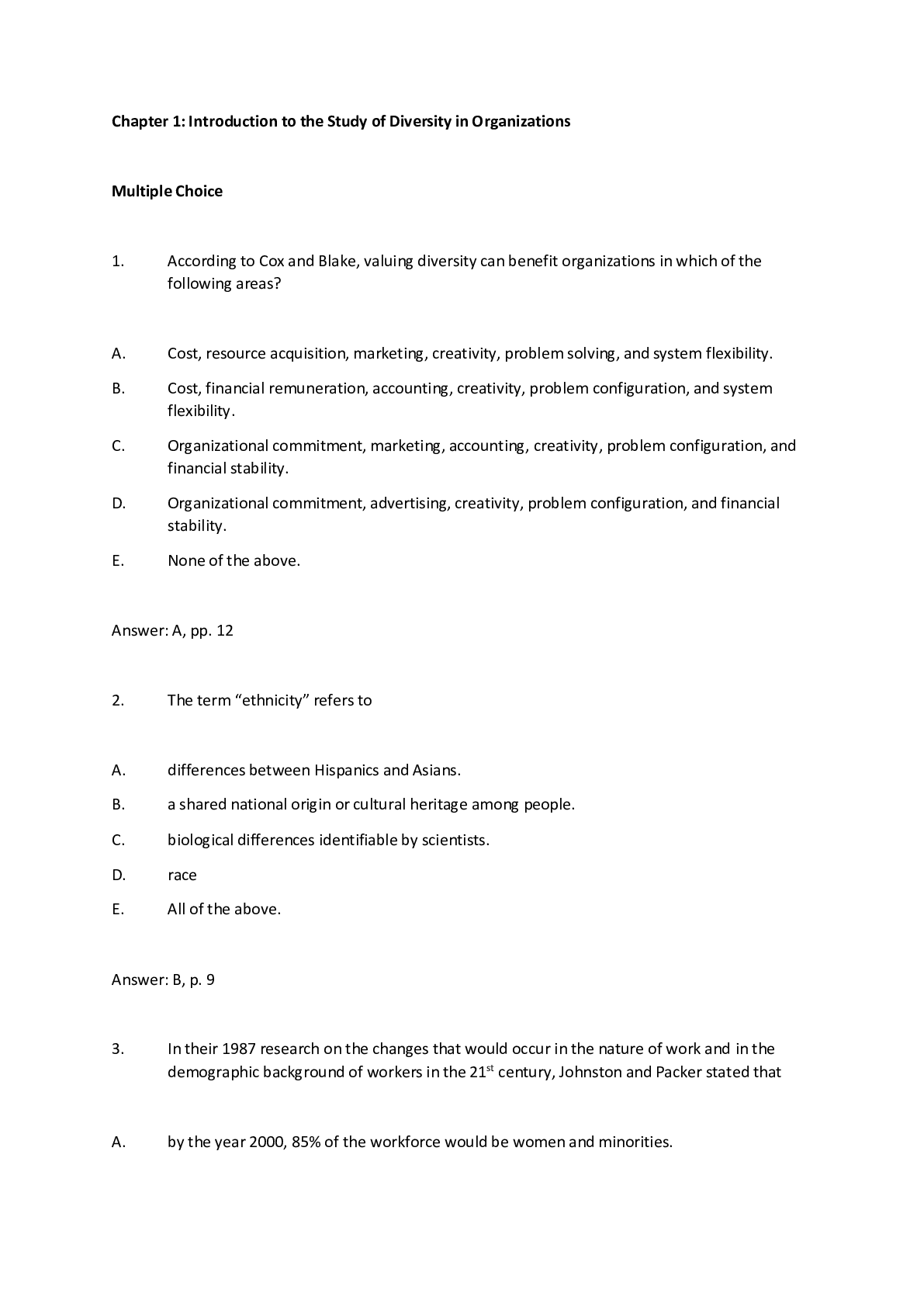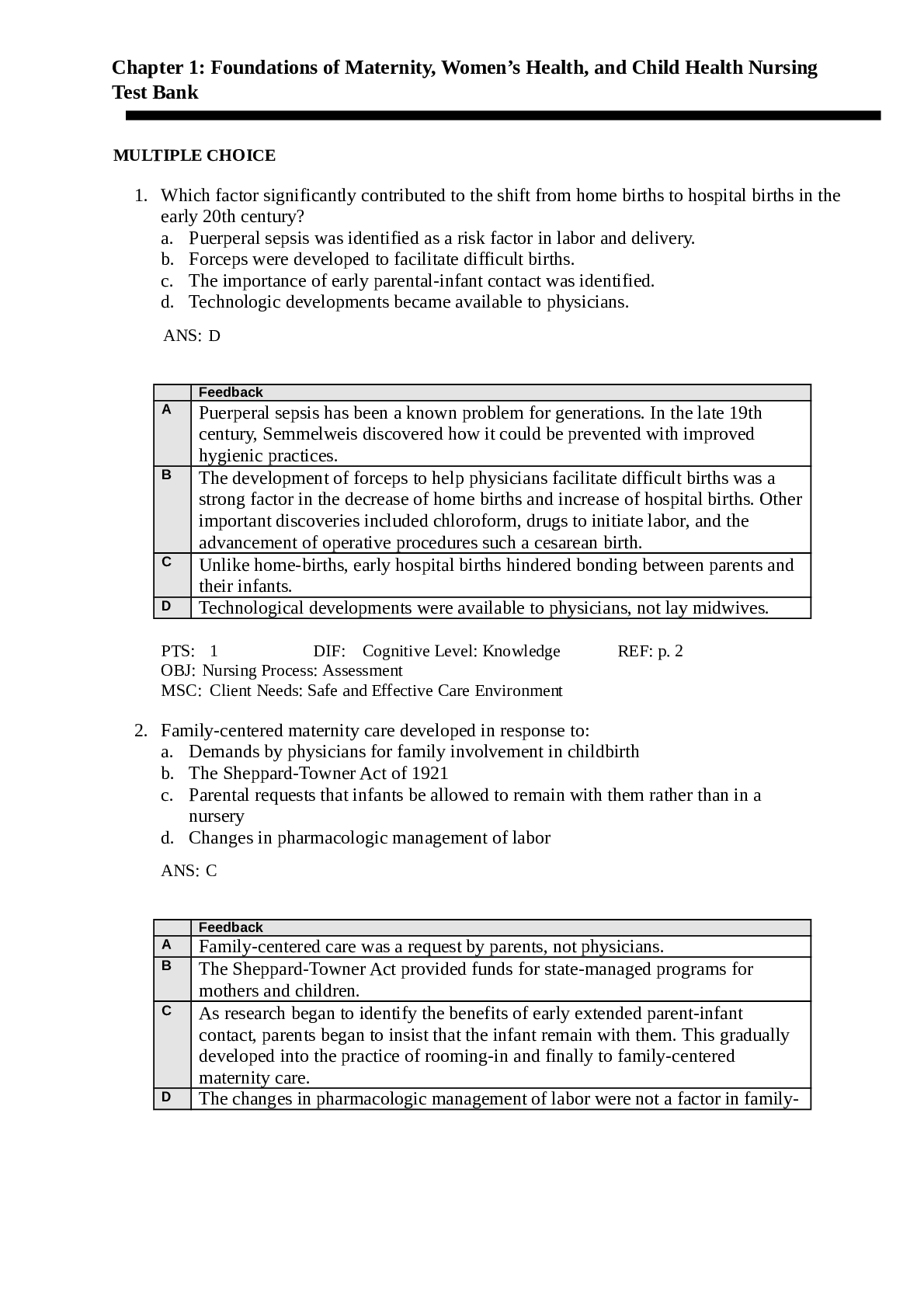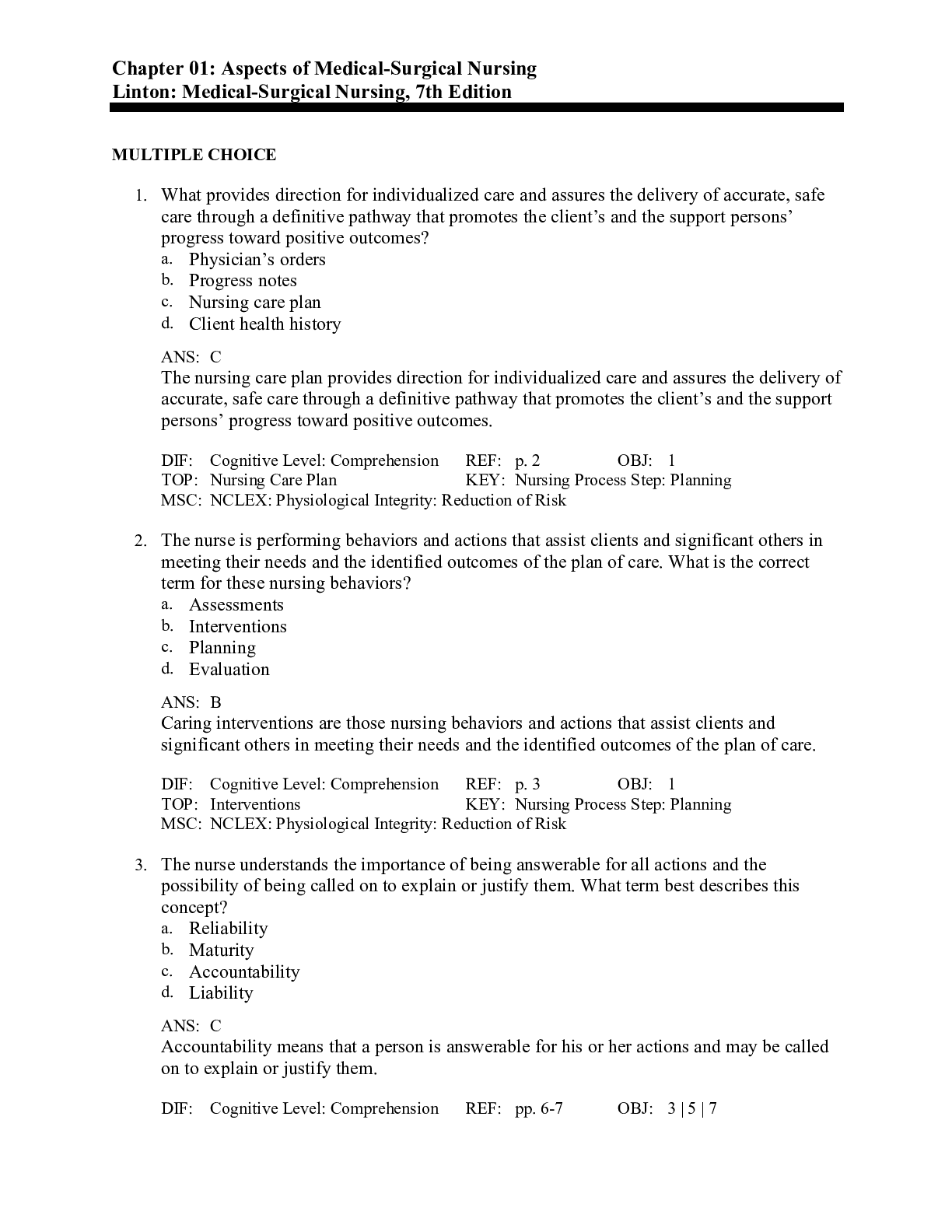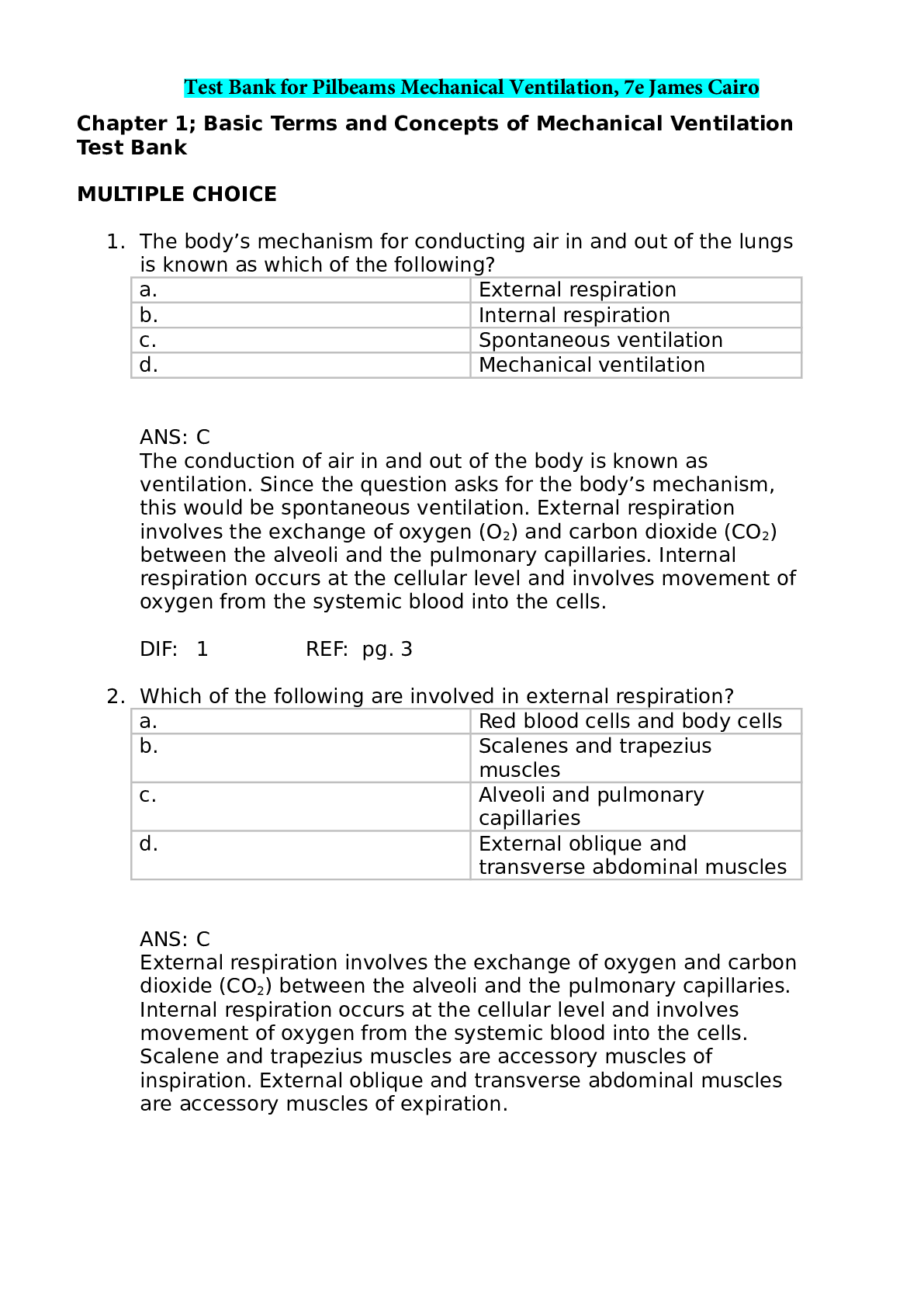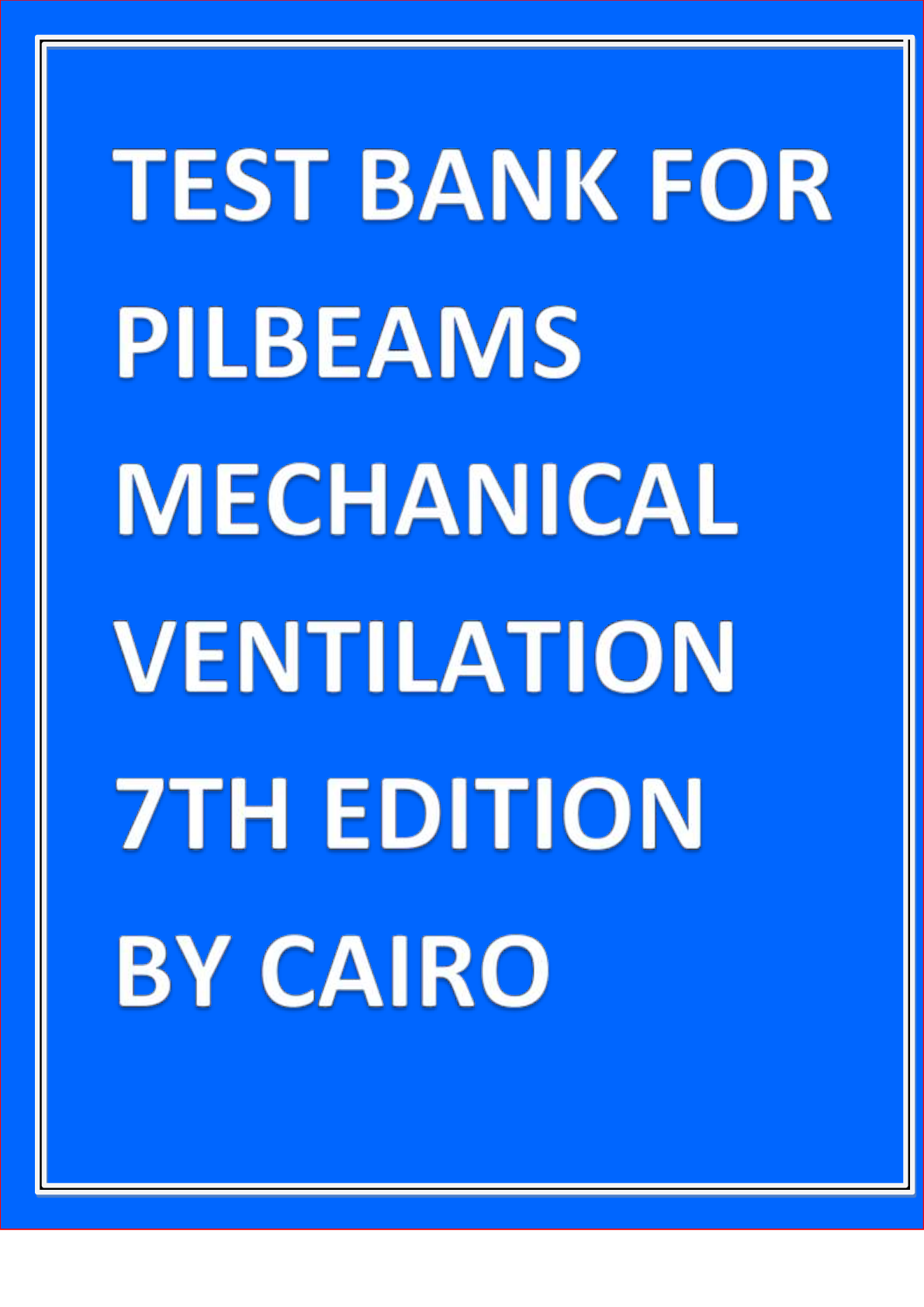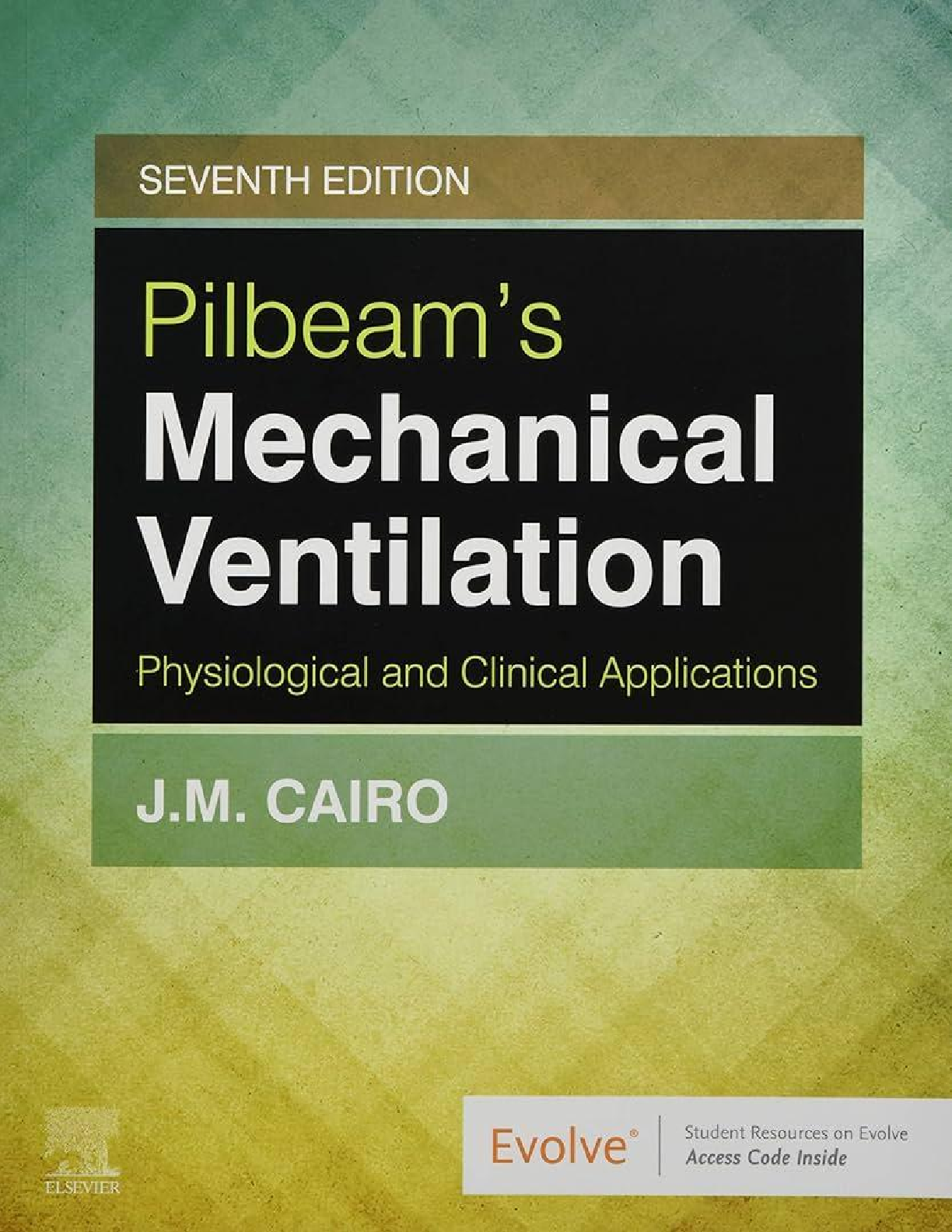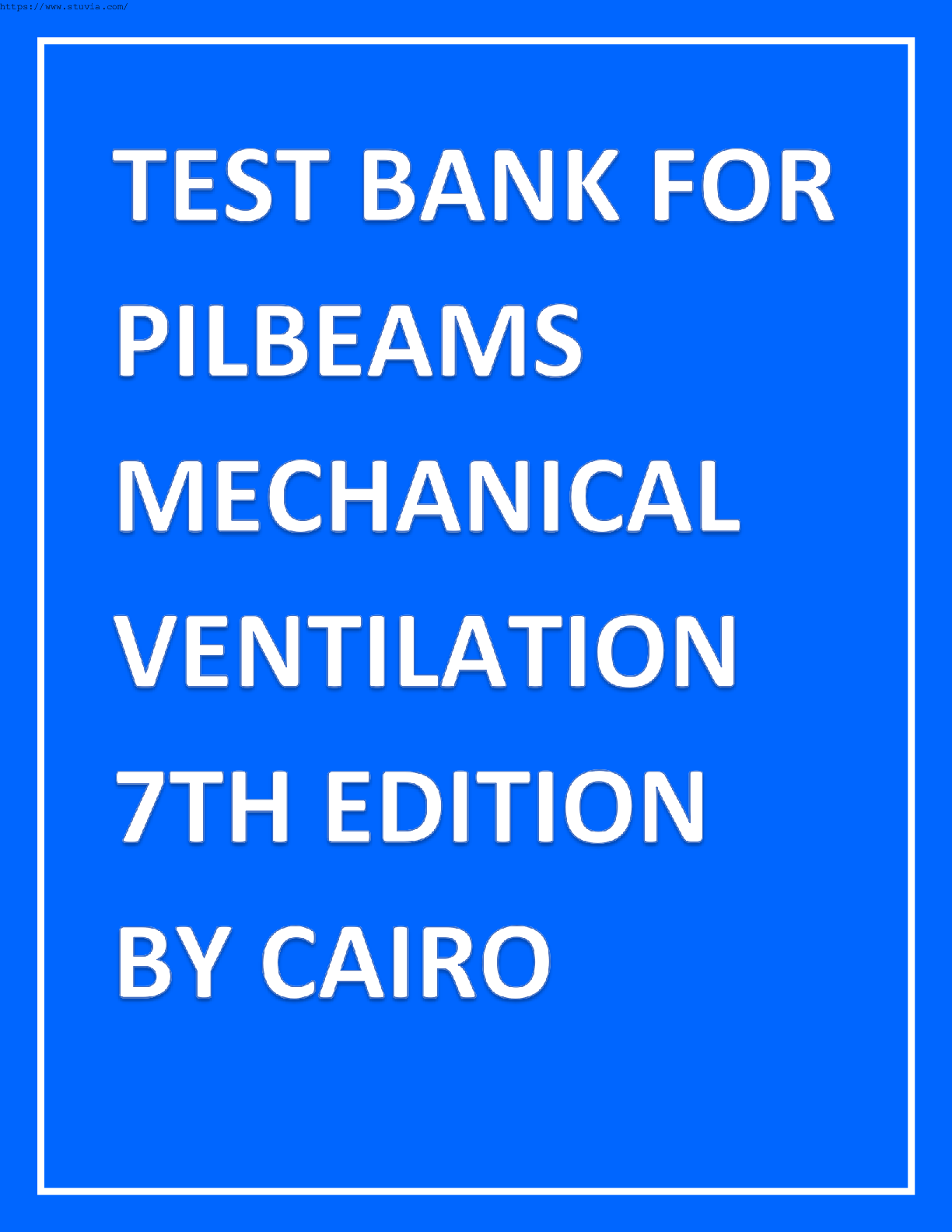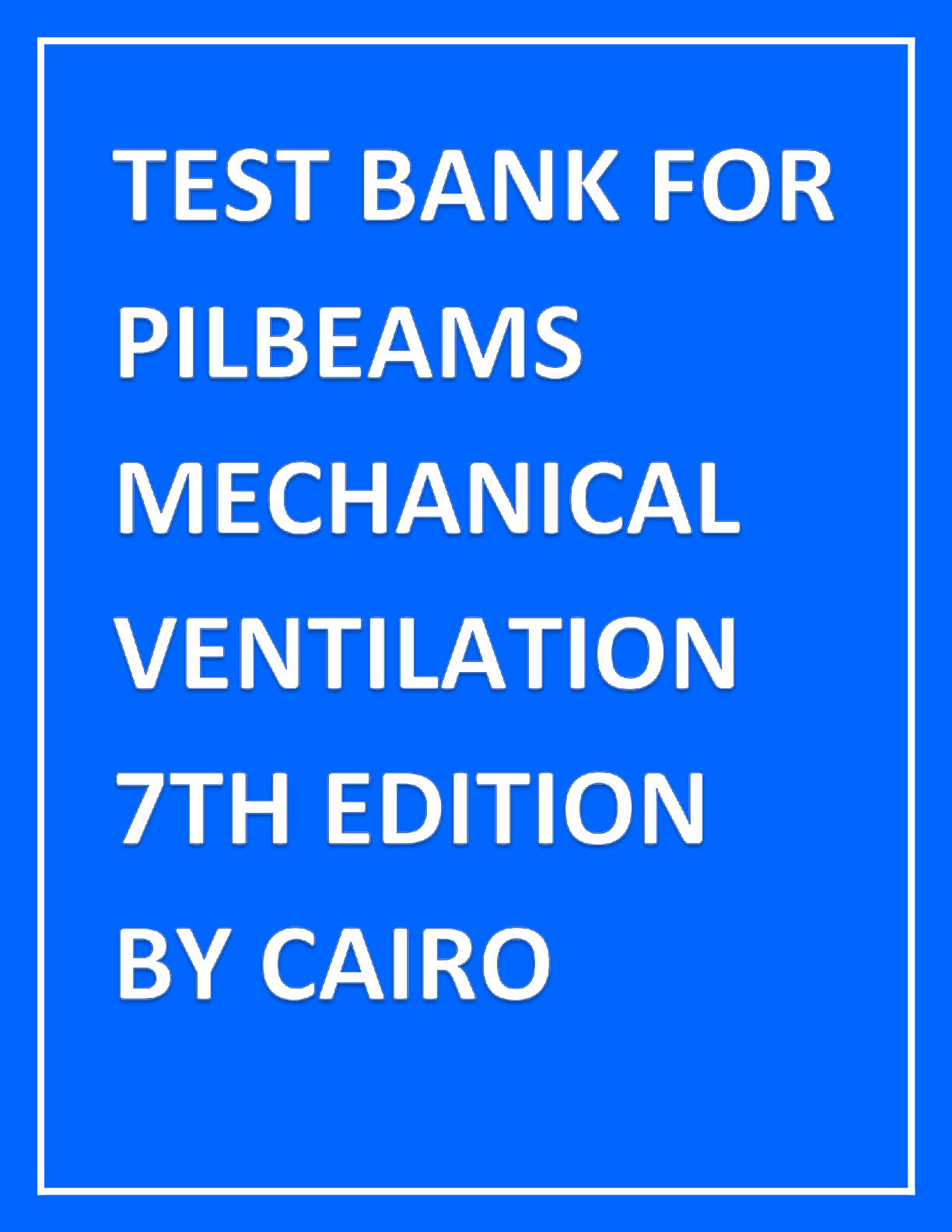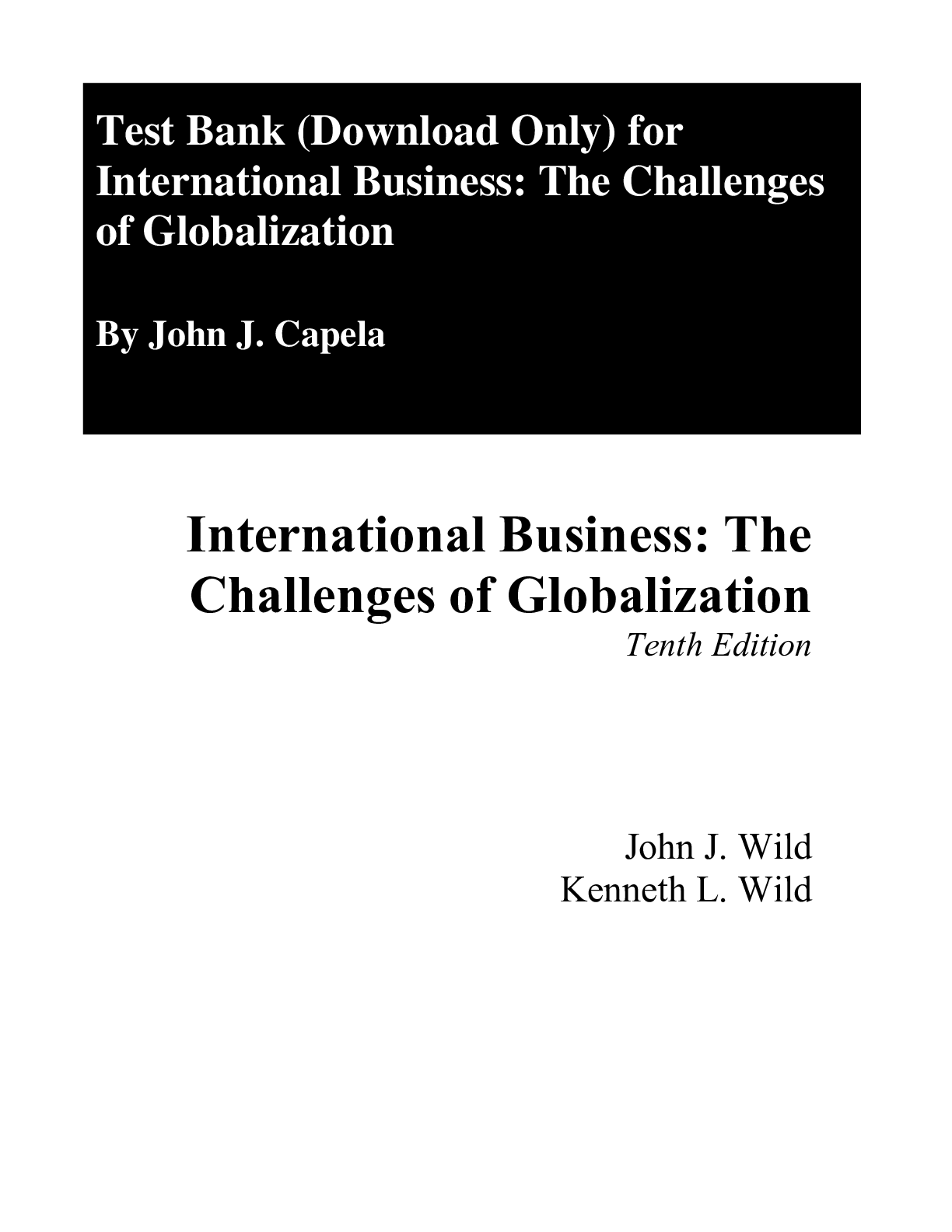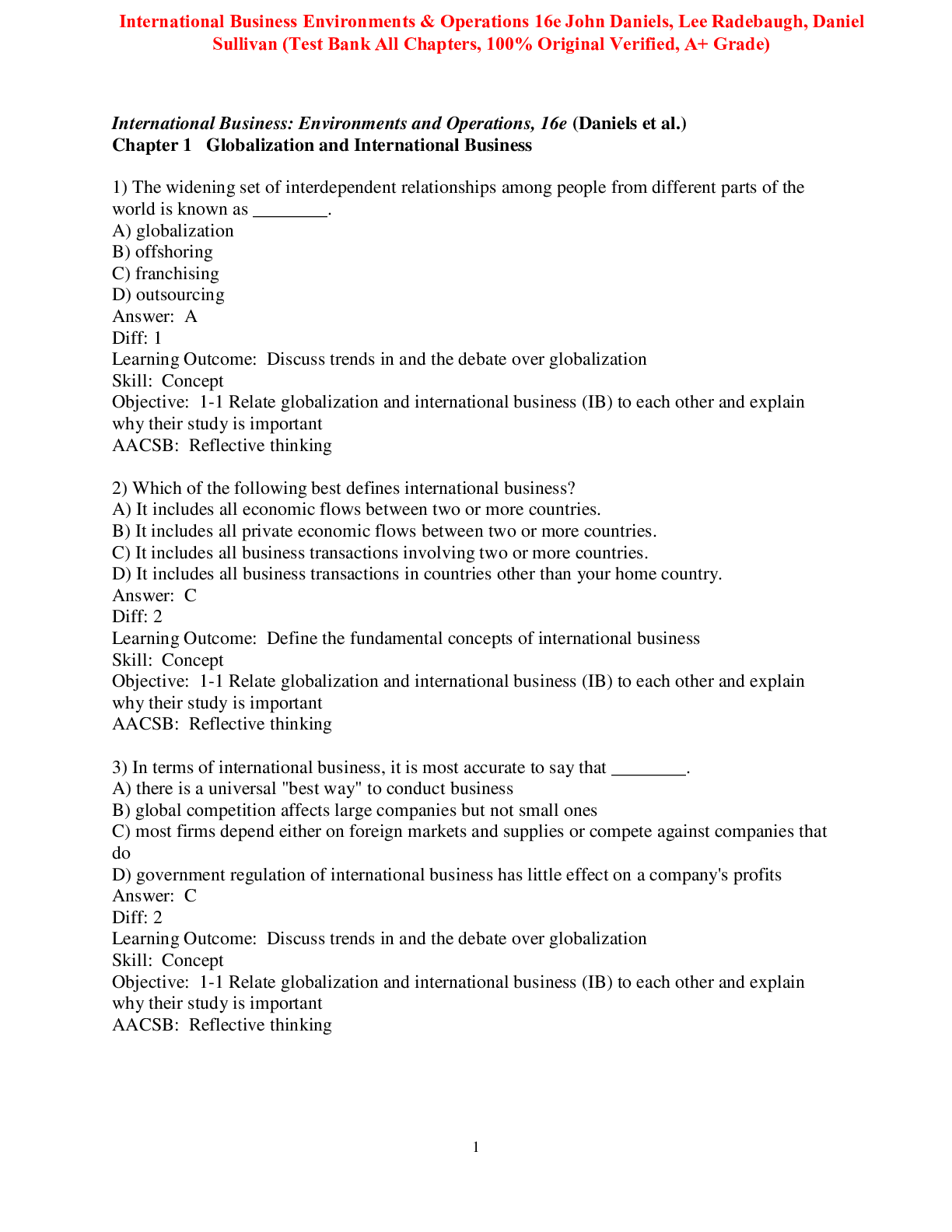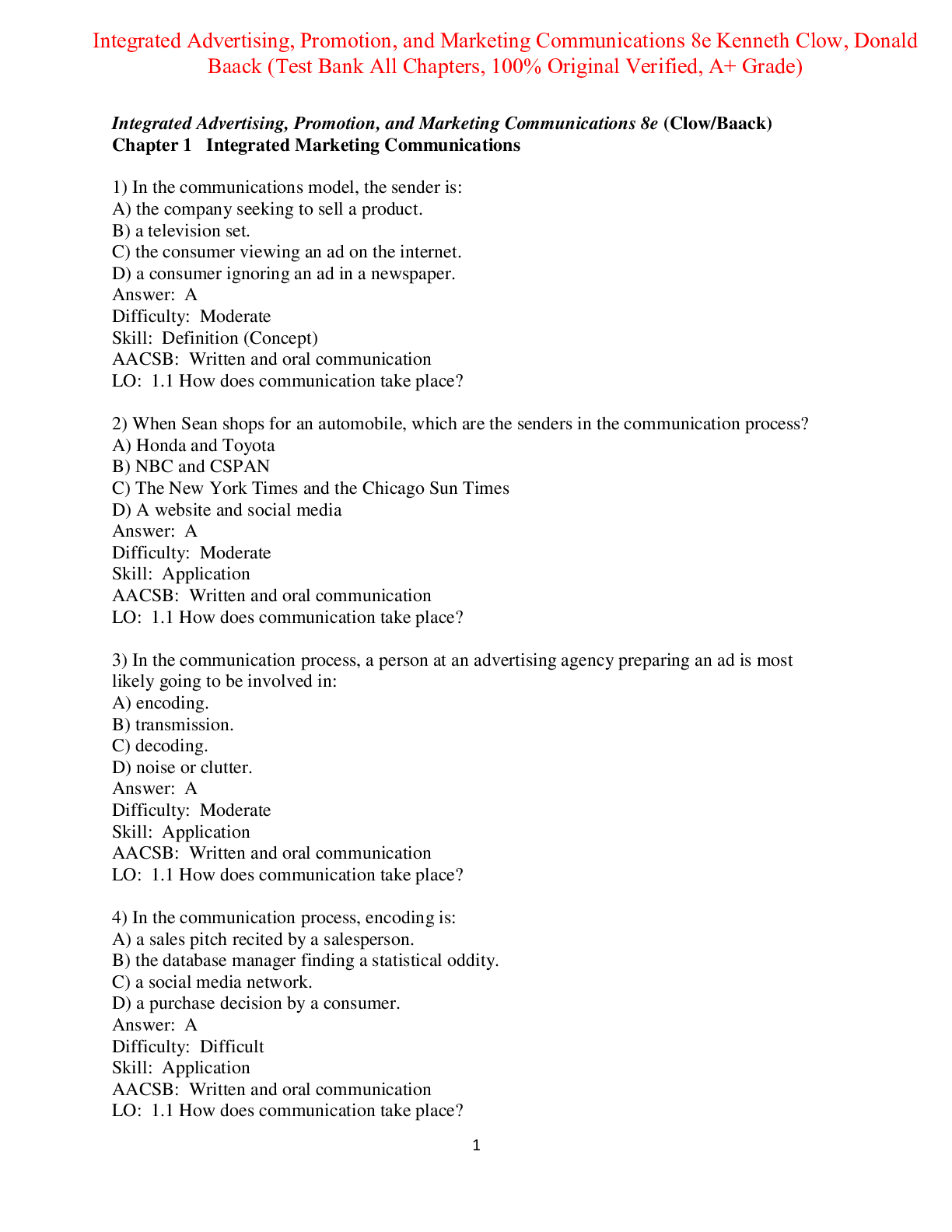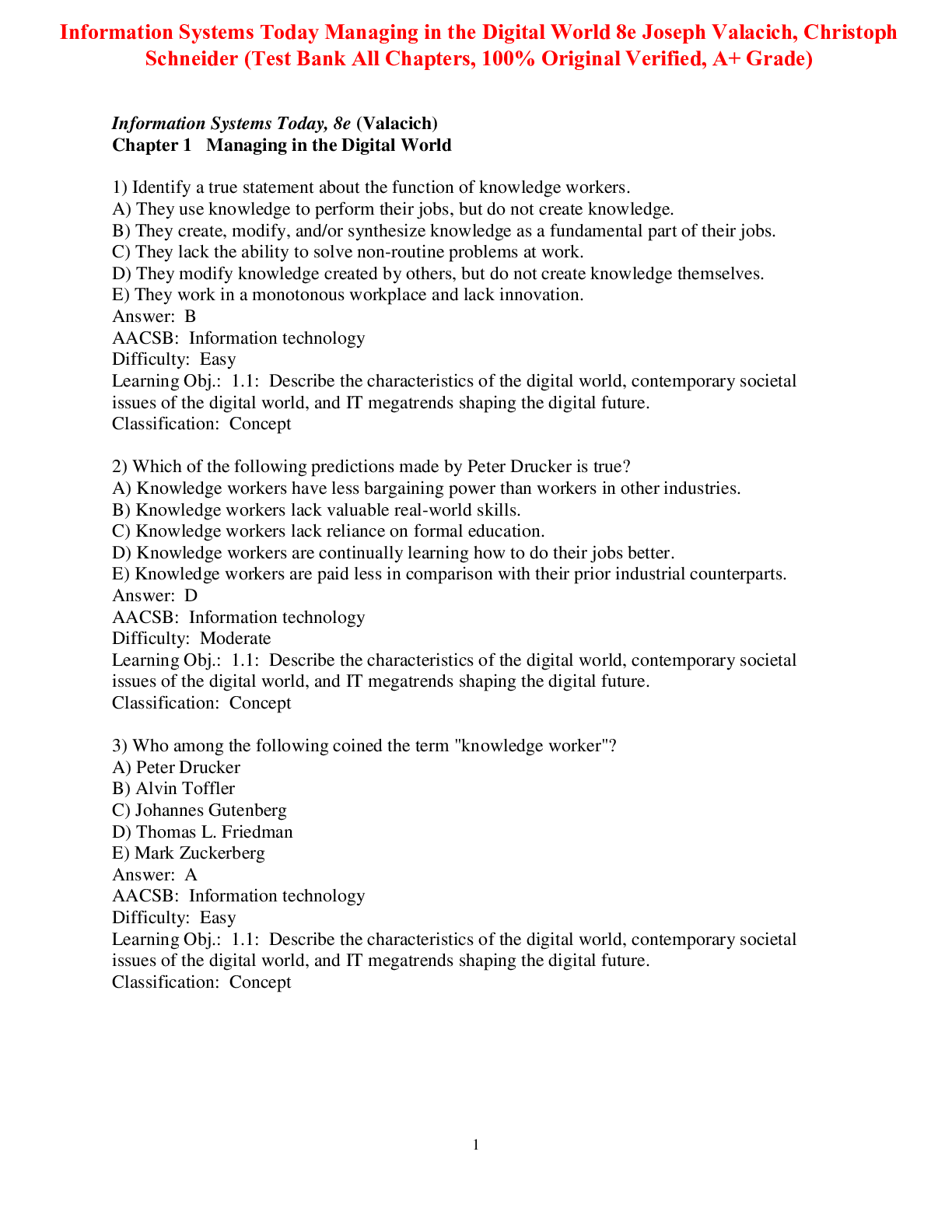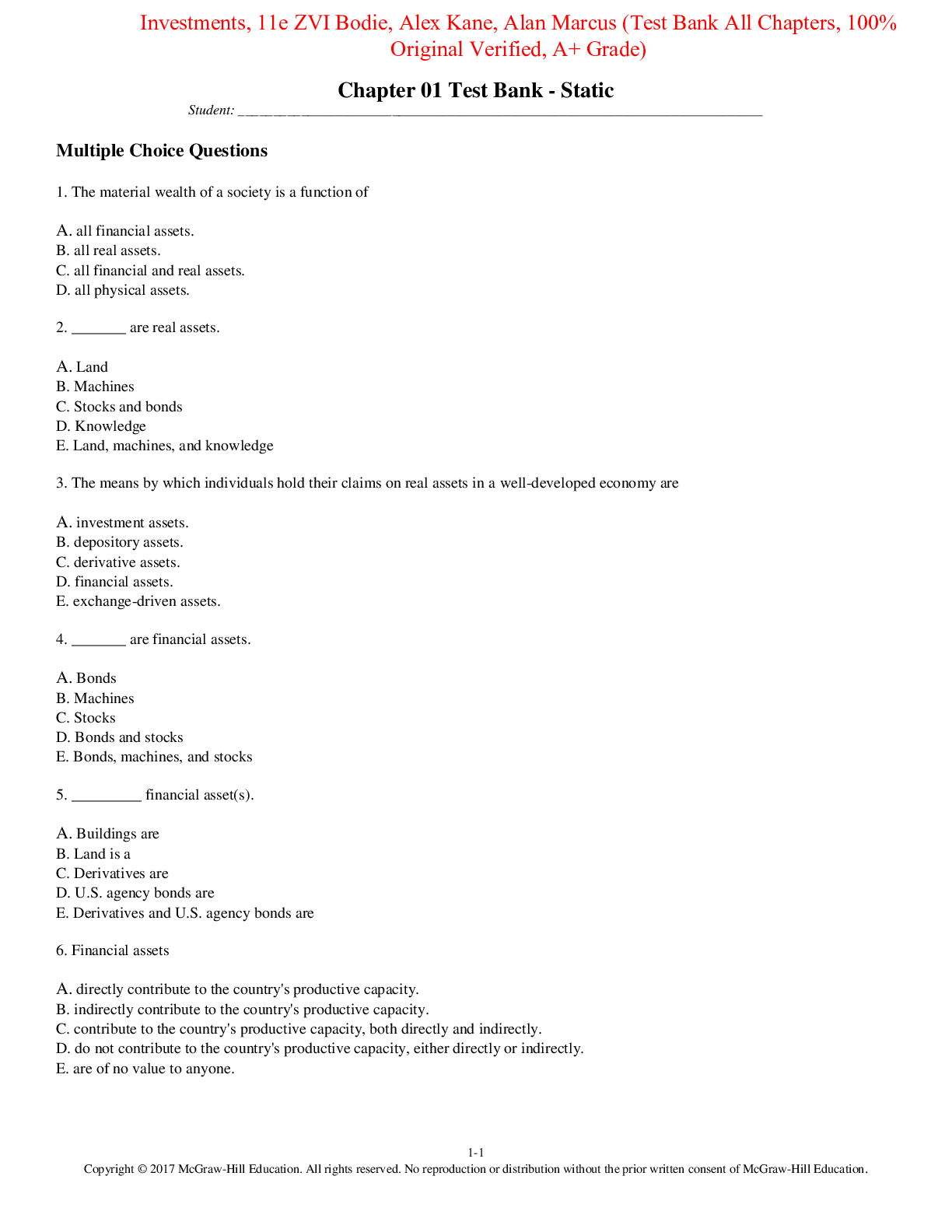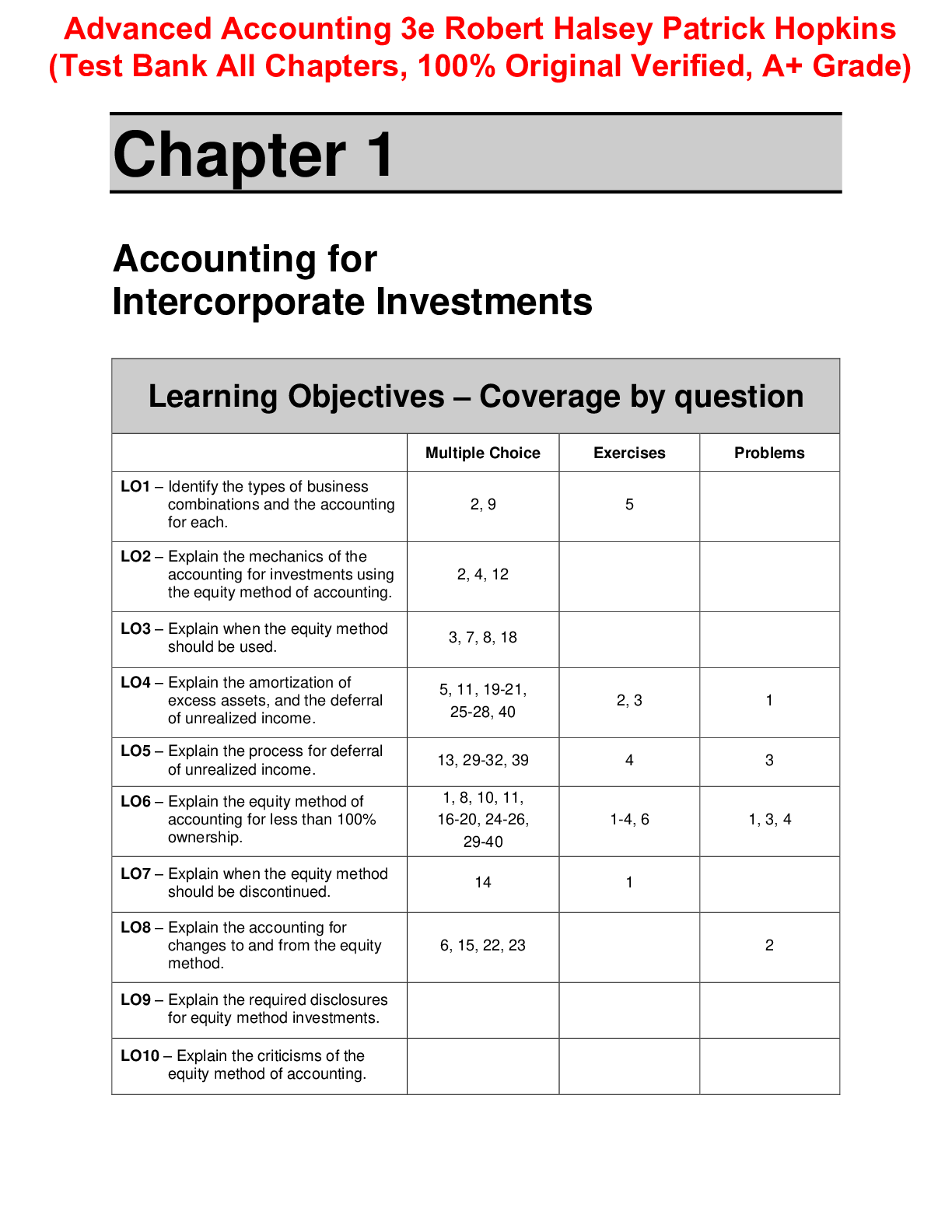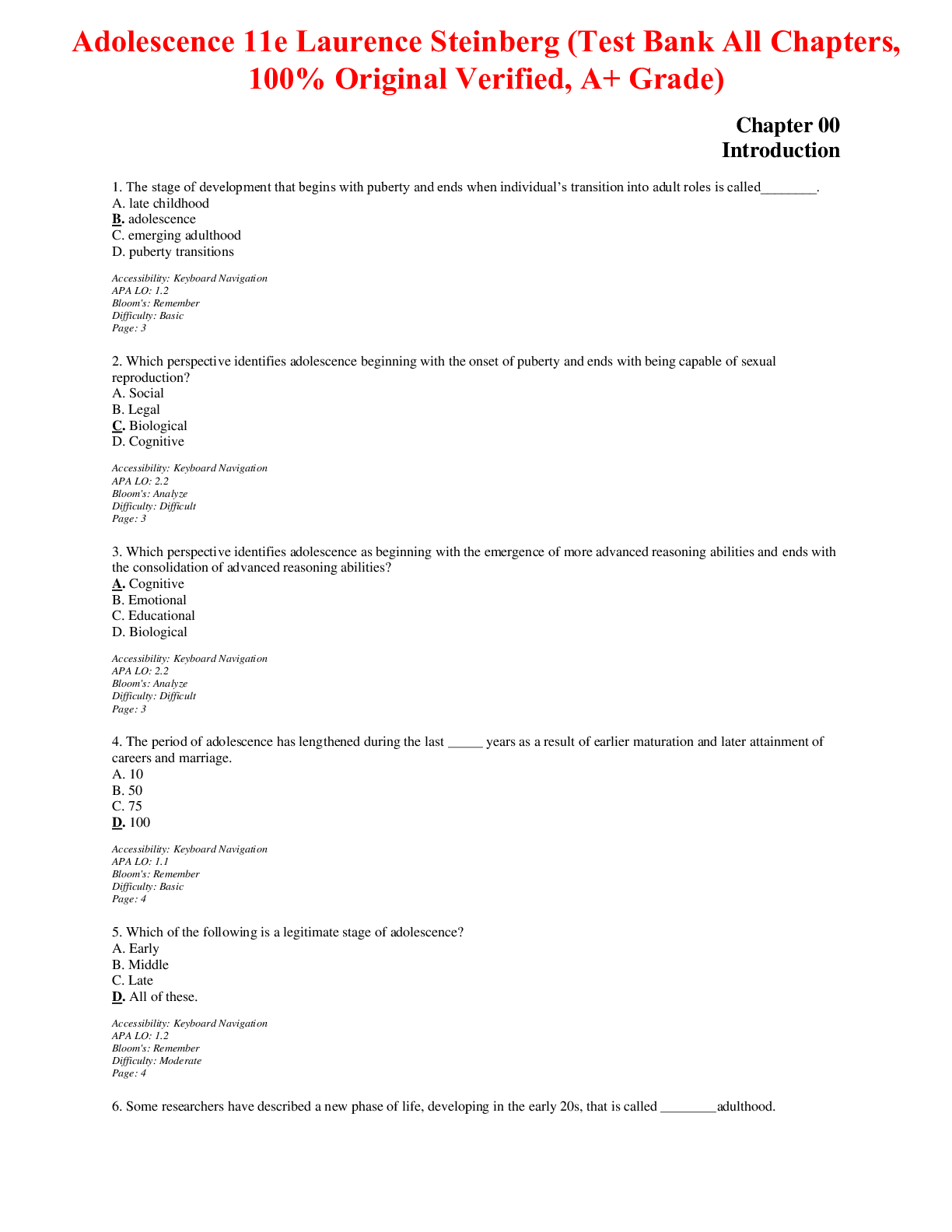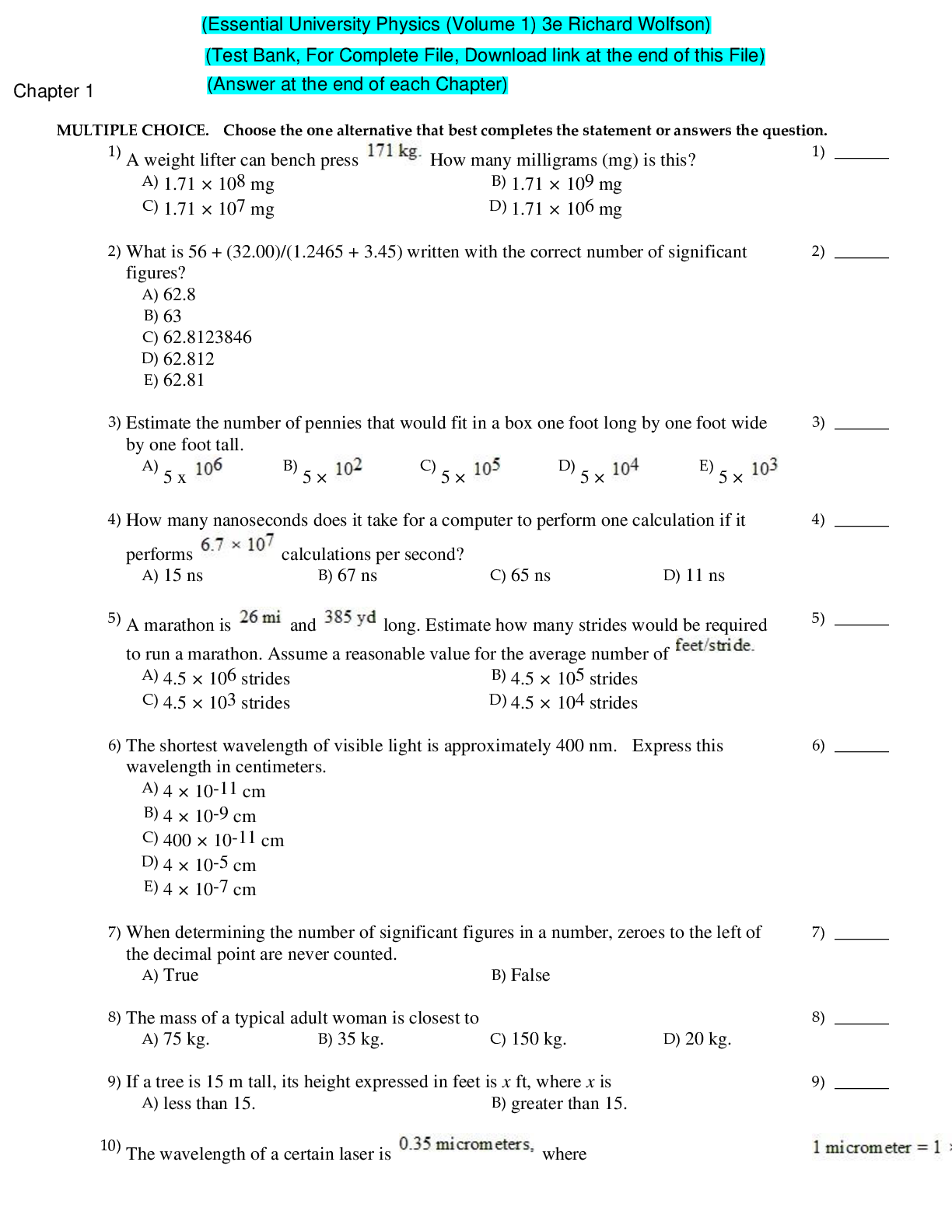Mechanical Engineering > TEST BANK > Test Bank for Pilbeams Mechanical Ventilation 7th Edition by Cairo (All)
Test Bank for Pilbeams Mechanical Ventilation 7th Edition by Cairo
Document Content and Description Below
Test Bank for Pilbeams Mechanical Ventilation 7th Edition by Cairo Chapter 01: Basic Terms and Concepts of Mechanical Ventilation Cairo: Pilbeam’s Mechanical Ventilation: Physiological and Clinical ... Applications, 7th Edition MULTIPLE CHOICE 1. The body’s mechanism for conducting air in and out of the lungs is known as which of the following? a. External respiration b. Internal respiration c. Spontaneous ventilation d. Mechanical ventilation ANS: C The conduction of air in and out of the body is known as ventilation. Since the question asks for the body’s mechanism, this would be spontaneous ventilation. External respiration involves the exchange of oxygen (O 2 ) and carbon dioxide (CO ) between the alveoli and the pulmonary capillaries. Internal respiration occurs at the cellular level and involves movement of oxygen from the systemic blood into the cells. 2. Which of the following are involved in external respiration? a. Red blood cells and body cells b. Scalenes and trapezius muscles c. Alveoli and pulmonary capillaries d. External oblique and transverse abdominal muscles ANS: C External respiration involves the exchange of oxygen and carbon dioxide (CO ) between the alveoli and the pulmonary capillaries. Internal respiration occurs at the cellular level and involves movement of oxygen from the systemic blood into the cells. Scalene 2 and trapezius muscles are accessory muscles of inspiration. External oblique and transverse abdominal muscles are accessory muscles of expiration. 3. The graph that shows intrapleural pressure changes during normal spontaneous breathing is depicted by which of the following? a. b. c. d. ANS: B During spontaneous breathing, the intrapleural pressure drops from about −5 cm H 2 . 1 2 O at end-expiration to about −10 cm H O at end-inspiration. The graph depicted for answer B shows that change from −5 cm H 4. During spontaneous inspiration alveolar pressure (P a. −1 cm H b. +1 cm H c. 0 cm H d. 5 cm H ANS: A 2 2 2 O 2 O O O A ) is about ________________. During normal spontaneous ventilation alveolar pressure will become −1 cm H 2 2 O to −10 cm H 2 O. O which is the lowest. During the exhalation of a normal spontaneous breath the alveolar pressure will become +1 cm H 2 O. 2 5. The pressure required to maintain alveolar inflation is known as which of the following? a. Transairway pressure (P b. Transthoracic pressure (P c. Transrespiratory pressure (P d. Transpulmonary pressure (P ANS: D TA ) TT ) TR L ) ) The definition of transpulmonary pressure (P L ) is the pressure required to maintain alveolar inflation. Transairway pressure (P ) is the pressure gradient required to produce airflow in the conducting tubes. Transrespiratory pressure (P ) is the pressure to inflate the lungs and airways during positive-pressure ventilation. Transthoracic pressure (P TT TR ) represents the pressure required to expand or contract the lungs and the chest wall at the same time. 6. Calculate the pressure needed to overcome airway resistance during positive-pressure ventilation when the proximal airway pressure (P a. 7 cm H b. 30 cm H c. 40 cm H awo d. 175 cm H ANS: B 2 O 2 2 ) is 35 cm H O O 2 O The transairway pressure (P 2 O and the alveolar pressure (P TA A ) is 5 cm H 2 O. ) is used to calculate the pressure required to overcome airway resistance during mechanical ventilation. This formula is P TA = P awo − P A. 7. The term used to describe the tendency of a structure to return to its original form after being stretched or acted on by an outside force is which of the following? a. Elastance b. Compliance c. Viscous resistance d. Distending pressure ANS: A The elastance of a structure is the tendency of that structure to return to its original shape after being stretched. The more elastance a structure has, the more difficult it is to stretch. The compliance of a structure is the ease with which the structure distends or stretches. Compliance is the opposite of elastance. Viscous resistance is the opposition to movement offered by adjacent structures such as the lungs and their adjacent organs. Distending pressure is pressure required to maintain inflation, for example, alveolar distending pressure. 8. Calculate the pressure required to achieve a tidal volume of 400 mL for an intubated patient with a respiratory system compliance of 15 mL/cm H a. 6 cm H 2 b. 26.7 cm H c. 37.5 cm H d. 41.5 cm H ANS: B O 2 2 2 2 O. O O O ΔC = ΔV/ΔP then ΔP = ΔV/ΔC 9. Which of the following conditions causes pulmonary compliance to increase? a. Asthma b. Kyphoscoliosis c. Emphysema d. Acute respiratory distress syndrome (ARDS) ANS: C Emphysema causes an increase in pulmonary compliance, whereas ARDS and kyphoscoliosis cause decreases in pulmonary compliance. Asthma attacks cause increase in airway resistance. 10. Calculate the effective static compliance (C ) given the following information about a patient receiving mechanical ventilation: peak inspiratory pressure (PIP) is 56 cm H 2 s O, plateau pressure (P plat ) is 40 cm H 2 O, exhaled tidal volume (V ) is 650 mL, and positive end-expiratory pressure (PEEP) is 10 cm H a. 14.1 mL/cm H b. 16.3 mL/cm H c. 21.7 mL/cm H d. 40.6 mL/cm H ANS: C 2 2 2 2 O O O O The formula for calculating effective static compliance is C 2 O. s = V T /(P plat − EEP). 11. Based upon the following patient information, calculate the patient’s static lung compliance: exhaled tidal volume (V peak inspiratory pressure (PIP) is 28 cm H a. 0.02 L/cm H b. 0.03 L/cm H c. 0.22 L/cm H d. 0.34 L/cm H ANS: C 2 2 2 2 O O O O 2 O, plateau pressure (P The formula for calculating effective static compliance is C s = V T plat ) is 8 cm H /(P plat − EEP). 2 O, and PEEP is set at 5 cm H . 2 T 2 O. T TA ) is 675 mL, 12. A patient receiving mechanical ventilation has an exhaled tidal volume (V ) of 500 mL and a positive end-expiratory pressure setting (PEEP) of 5 cm H O. Patient-ventilator system checks reveal the following data: Time PIP (cm H 2 2 O) P plat (cm H O) 0600 27 15 2 0800 29 15 1000 36 13 The respiratory therapist should recommend which of the following for this patient? 1. Tracheobronchial suctioning 2. Increase in the set tidal volume 3. β adrenergic bronchodilator therapy 4. Increase positive end-expiratory pressure a. 1 and 3 only b. 2 and 4 only c. 1, 2, and 3 only d. 2, 3, and 4 only ANS: A Calculate the transairway pressure (P TA T ) by subtracting the plateau pressure from the peak inspiratory pressure. Analyzing the P will show any changes in the pressure needed to overcome airway resistance. Analyzing the P will demonstrate any changes in compliance. The P plateau plateau remained the same for the first two checks and then actually dropped at the 1000-hour check. Analyzing the P TA , however, shows a slight increase between 0600 and 0800 (from 12 to 14 cm H 2 O) and then a sharp increase to 23 cm H O at 1000. Increases in P signify increases in airway resistance. Airway resistance may be caused by secretion buildup, bronchospasm, mucosal edema, and mucosal inflammation. Tracheobronchial suctioning will remove any secretion buildup, and a β adrenergic bronchodilator will reverse bronchospasm. Increasing the tidal volume will add to the airway resistance according to TA Poiseuille’s law. Increasing the PEEP will not address the root of this patient’s problem; the patient’s compliance is normal. 13. The values below pertain to a patient who is being mechanically ventilated with a measured exhaled tidal volume (V ) of 700 mL. Time Peak Inspiratory Pressure (cm H 2 O) Plateau Pressure (cm H O) 0800 35 30 2 1000 39 34 1100 45 39 1130 50 44 Analysis of this data points to which of the following conclusions? a. Airway resistance is increasing. b. Airway resistance is decreasing. c. Lung compliance is increasing. d. Lung compliance is decreasing. ANS: D To evaluate this information the transairway pressure (P TA ) is calculated for the different times: 0800 P = 5 cm H 2 O, 1100 P TA = 6 cm H 2 O, and 1130 P TA = 6 cm H 2 TA . 3 = 5 cm H O. This data shows that there is no significant increase or decrease in this patient’s airway resistance. Analysis of the patient’s plateau pressure (P plat ) reveals an increase of 15 cm H O over the three and a half hour time period. This is directly related to a decrease in lung compliance. Calculation of the lung compliance (C S =V T /(P plat − EEP))at each time interval reveals a steady decrease from 20 mL/cm H 2 O to 14 mL/cm H 14. The respiratory therapist should expect which of the following findings while ventilating a patient with acute respiratory distress syndrome (ARDS)? a. An elevated plateau pressure (P b. A decreased elastic resistance c. A low peak inspiratory pressure (PIP) d. A large transairway pressure (P ANS: A plat TA ) ) gradient ARDS is a pathological condition that is associated with a reduction in lung compliance. The formula for static compliance (C ) utilizes the measured plateau pressure (P plat ) in its denominator (C S = V T /[P – EEP]). Therefore, with a consistent exhaled tidal volume (V T ), an elevated P plat will decrease C S . 15. The formula used for the calculation of static compliance (C a. (Peak inspiratory pressure [PIP] − EEP)/tidal volume (V b. (Plateau pressure [P plat ] − EEP)/tidal volume (V c. Tidal volume/(plateau pressure − EEP) d. Tidal volume/(peak pressure [PIP] − plateau pressure [P ANS: C C S =V T /(P plat − EEP) T ) S plat ) is which of the following? T ) plat ]) 2 2 O. 2 T O, 1000 P 2 TA TA S 16. Plateau pressure (P a. Inspiration b. End-inspiration c. Expiration d. End-expiration ANS: B plat ) is measured during which phase of the ventilatory cycle? The calculation of compliance requires the measurement of the plateau pressure. This pressure measurement is made during no-flow conditions. The airway pressure (P ) is measured at end-inspiration. The inspiratory pressure is taken when the pressure reaches its maximum during a delivered mechanical breath. The pressure that occurs during expiration is a dynamic measurement awo and drops during expiration. The pressure reading at end-expiration is the baseline pressure; this reading is either at zero (atmospheric pressure) or at above atmospheric pressure (PEEP). 17. The condition that is associated with an increase in airway resistance is which of the following? a. Pulmonary edema b. Bronchospasm c. Fibrosis d. Ascites ANS: B Airway resistance is determined by the gas viscosity, gas density, tubing length, airway diameter, and the flow rate of the gas through the tubing. The two factors that are most often subject to change are the airway diameter and the flow rate of the gas. The flow rate of the gas during mechanical ventilation is controlled. Pulmonary edema is fluid accumulating in the alveoli and will cause a drop in the patient’s lung compliance. Bronchospasm causes a narrowing of the airways and will, therefore, increase the airway resistance. Fibrosis causes an inability of the lungs to stretch, decreasing the patient’s lung compliance. Ascites causes fluid buildup in the peritoneal cavity and increases tissue resistance, not airway resistance. 18. An increase in peak inspiratory pressure (PIP) without an increase in plateau pressure (P ) is associated with which of the following? a. Increase in static compliance (C b. Decrease in static compliance (C c. Increase in airway resistance d. Decrease in airway resistance ANS: C S ) S ) The PIP represents the amount of pressure needed to overcome both elastance and airway resistance. The P plat is the amount of pressure required to overcome elastance alone. Since the P has remained constant in this situation, the static compliance is unchanged. The difference between the PIP and the P plat plat is the transairway pressure (P ) and represents the pressure required to overcome the airway resistance. If P TA TA . 4 plat increases, the airway resistance is also increasing, when the gas flow rate remains the same. 19. The patient-ventilator data over the past few hours demonstrates an increased peak inspiratory pressure (PIP) with a constant transairway pressure (P a. Static compliance (C b. Static compliance (C c. Airway resistance (R d. Airway resistance (R ANS: B TA ). The respiratory therapist should conclude which of the following? S S ) has increased. ) has decreased. aw aw ) has increased. ) has decreased. The PIP represents the amount of pressure needed to overcome both elastance and airway resistance. The P is the amount of pressure required to overcome elastance alone, and is the pressure used to calculate the static compliance. Since P has stayed the same, it can be concluded that R has remained the same. Therefore, the reason the PIP has increased is because of an increase in the P plat aw . [Show More]
Last updated: 9 months ago
Preview 1 out of 282 pages

Reviews( 0 )
Document information
Connected school, study & course
About the document
Uploaded On
Aug 16, 2023
Number of pages
282
Written in
Additional information
This document has been written for:
Uploaded
Aug 16, 2023
Downloads
0
Views
46

.png)

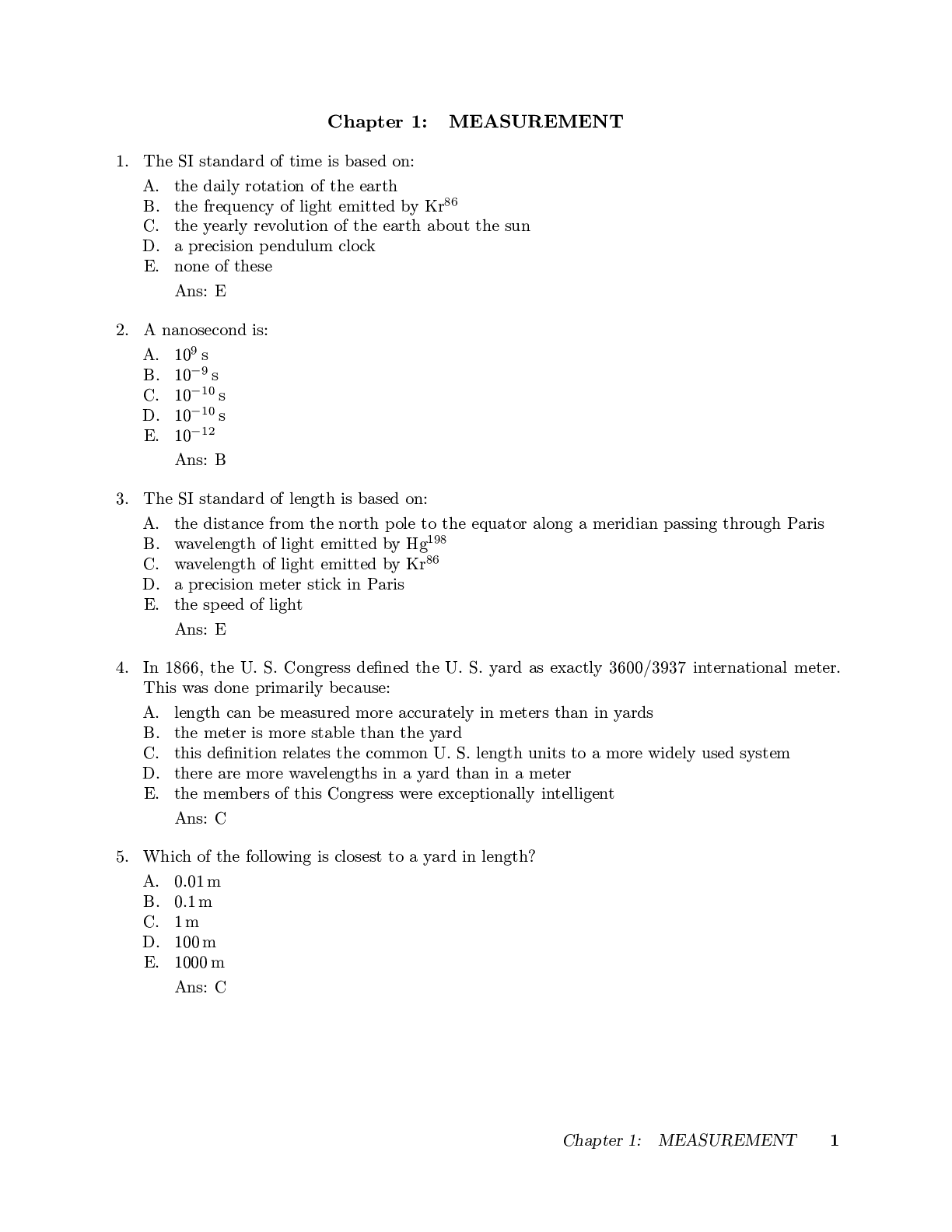
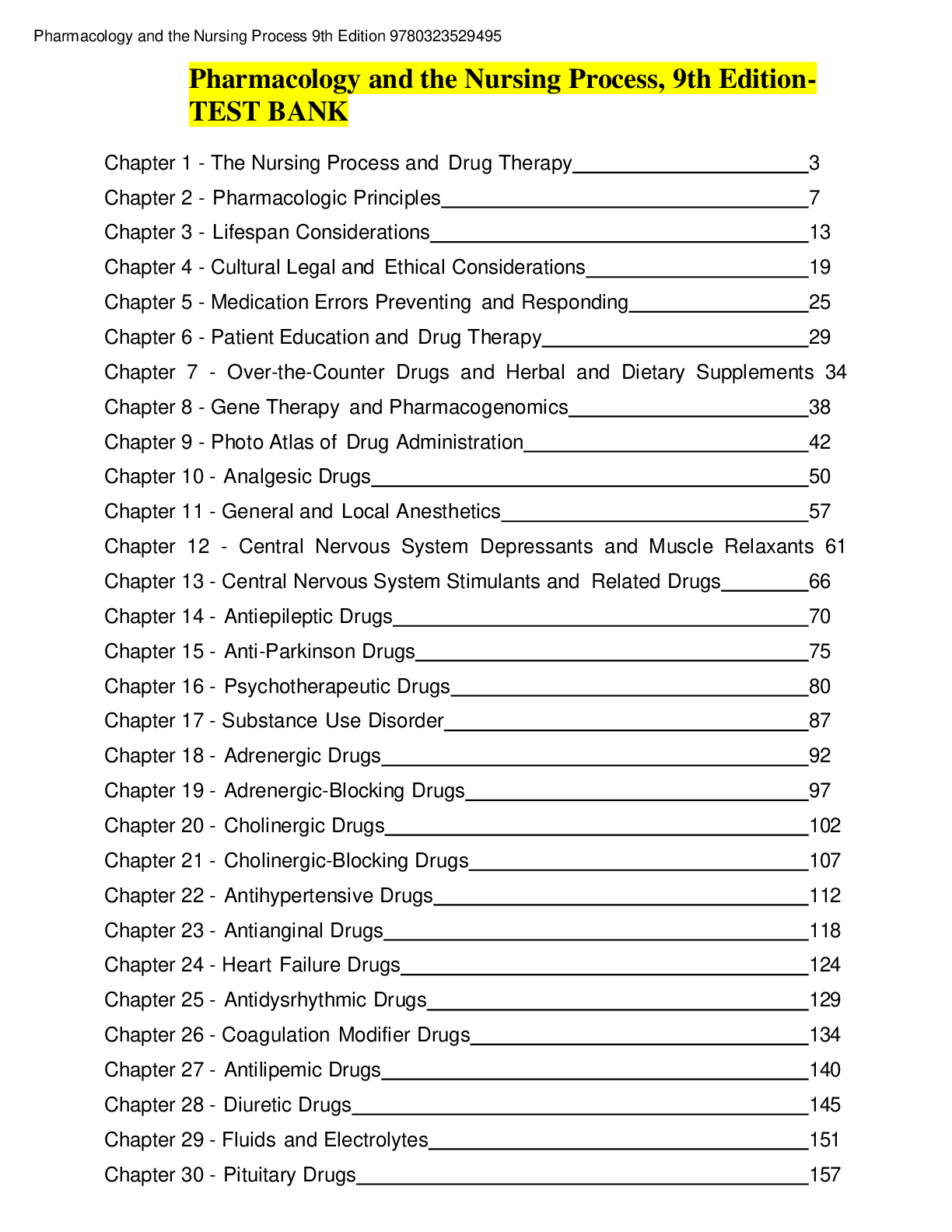
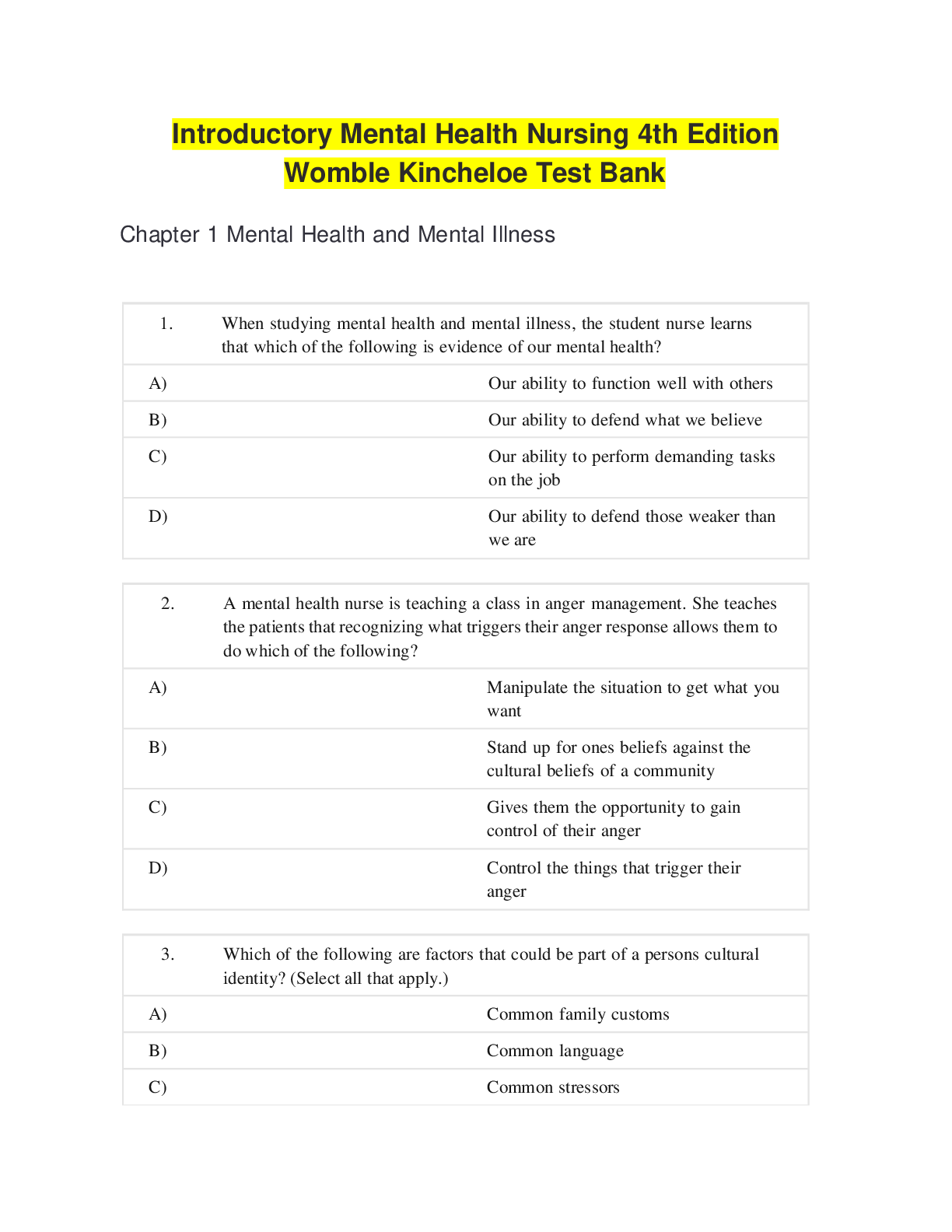
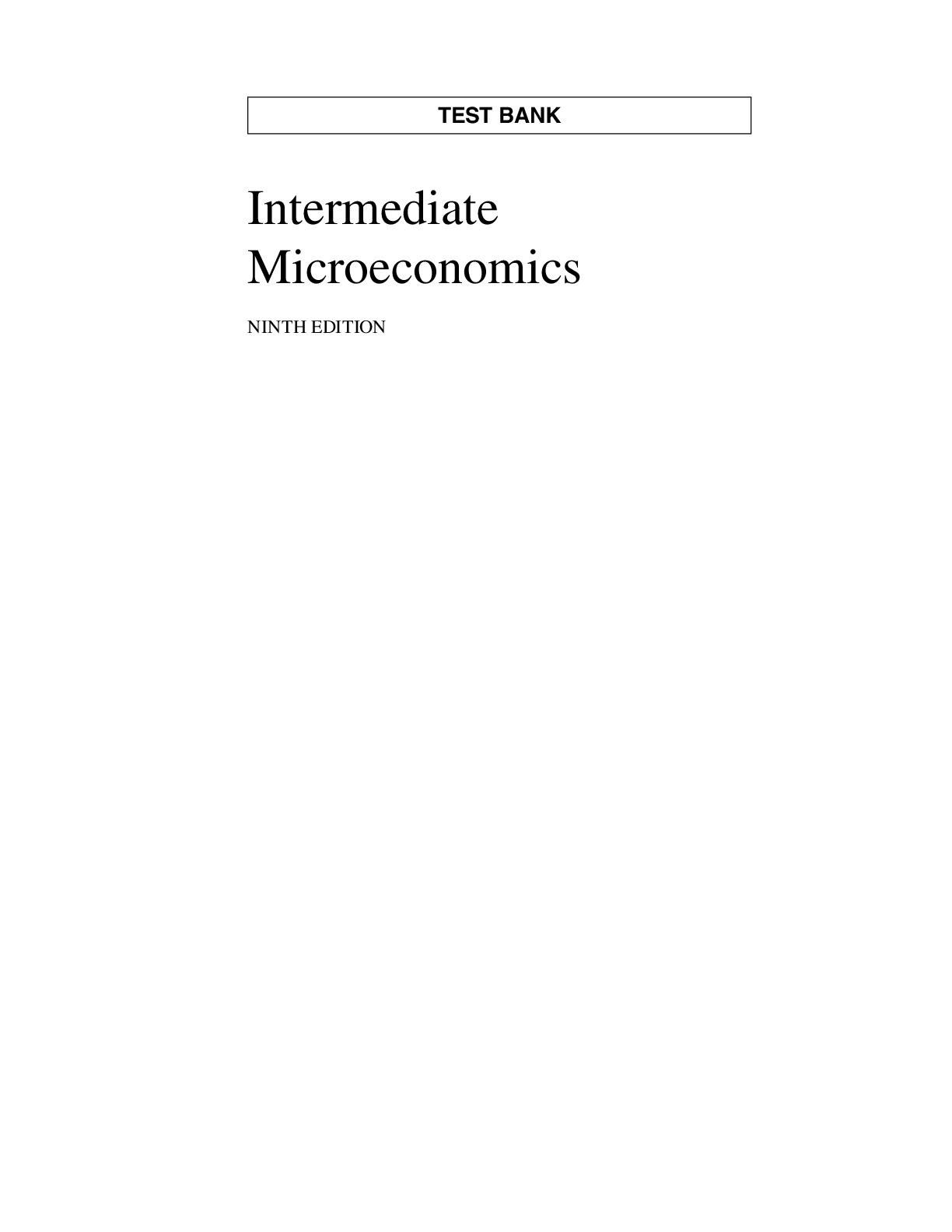

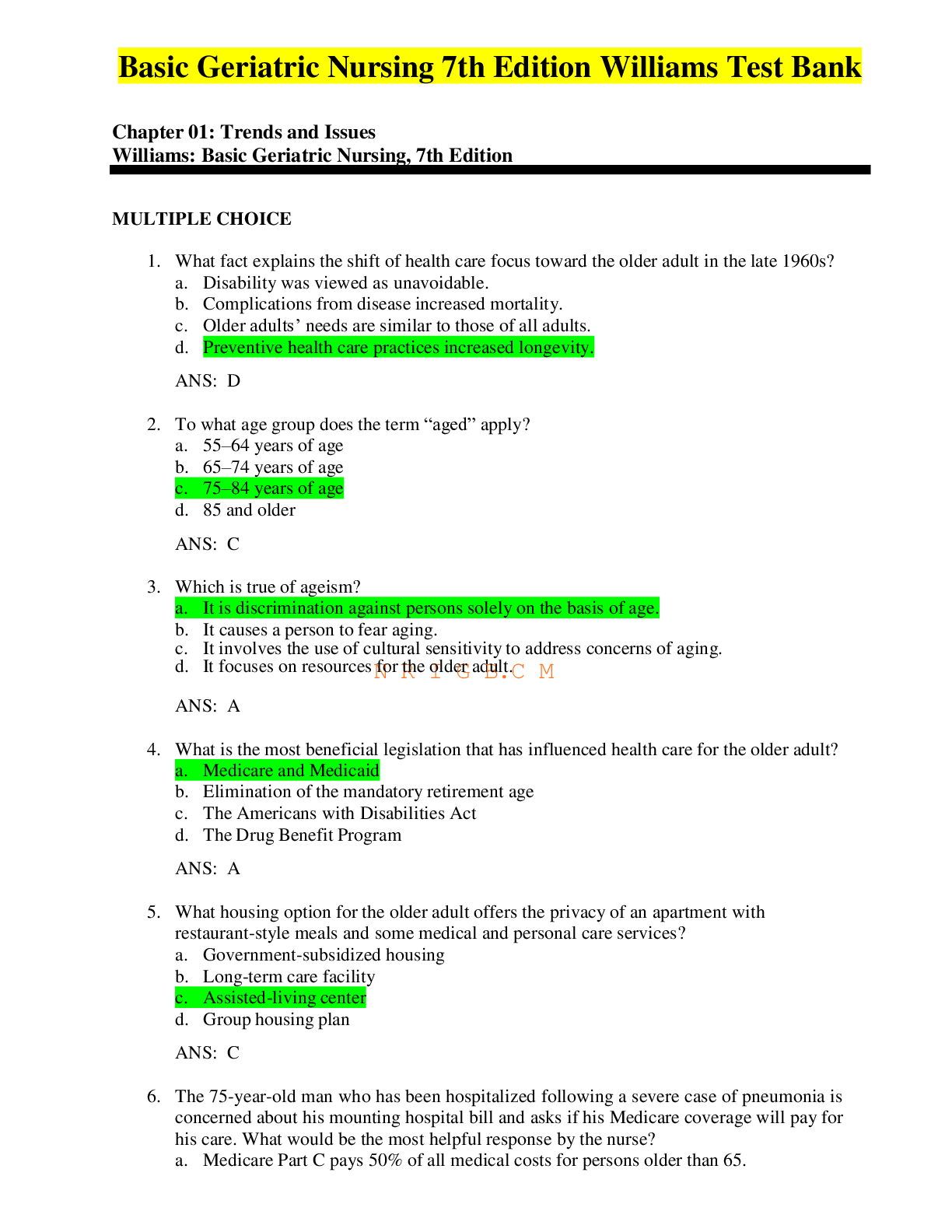
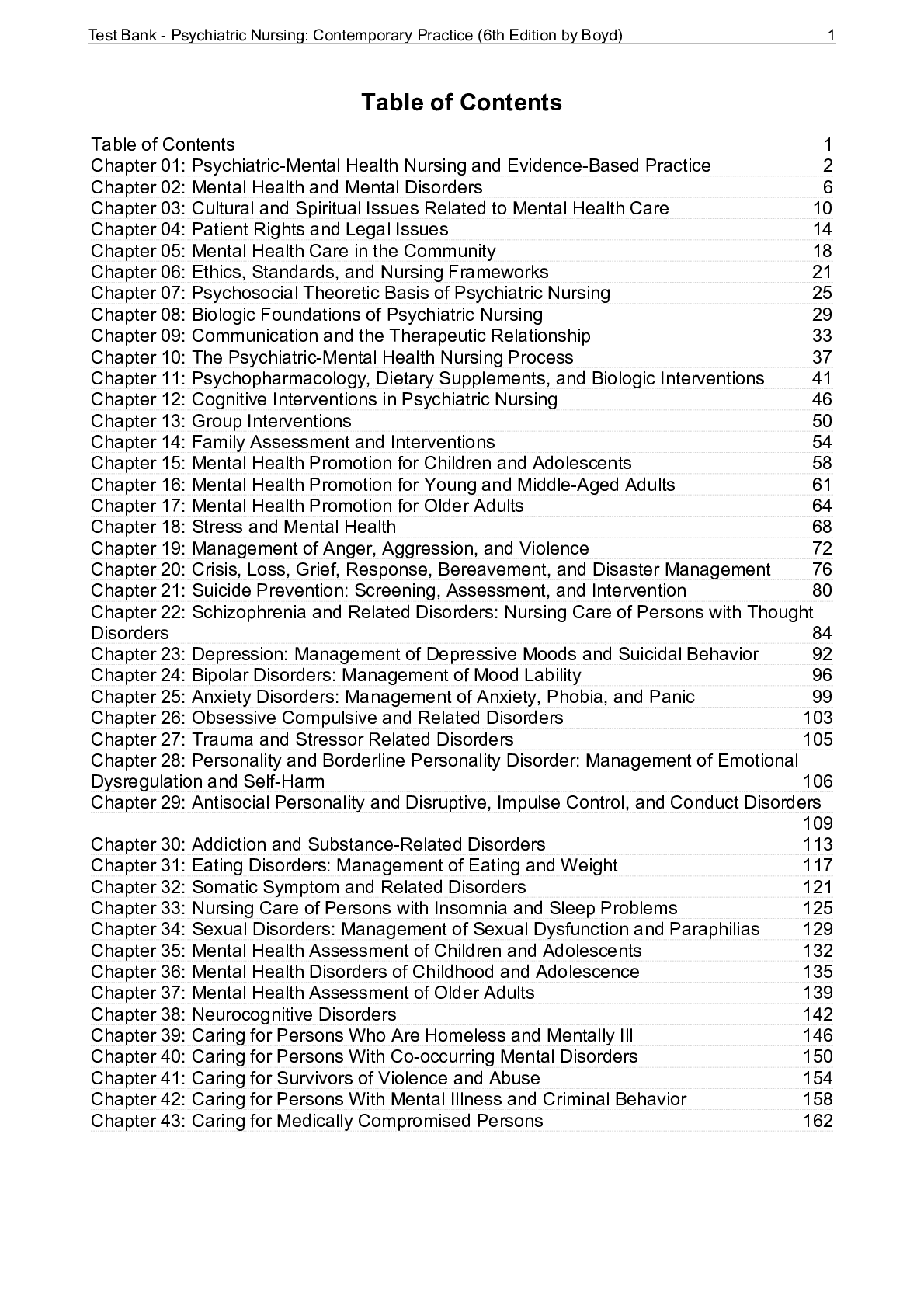
.png)
